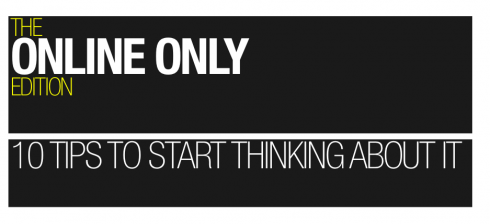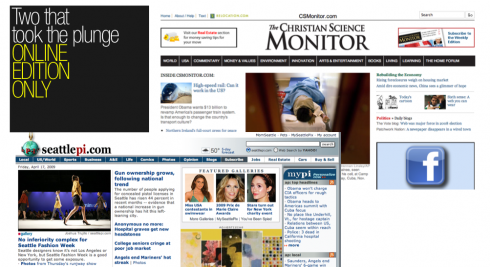

The Christian Science Monitor and The Seattle-Post Intelligencer both publish online only editions. The Monitor prints a weekend edition as well.
It is Friday, end of an intensely busy week. Don’t know why, but on Fridays thoughts turn to the weekend (for some), and the week that was (for others), and for a few of us to the months ahead.
It has been a week of work with L’Equipe Magazine in Paris, as we worked feverishly with the team, under the leadership of editors in chief Jean-Philippe Leclaire and Jean-Denis Walter, and art director Francois Lollichon. The Mag, as everyone calls it, has now gone to press, and we will sample the first printed issues today, and readers will see it as the weekend supplement to L’Equipe newspaper tomorrow Saturday all over France.
We hope the readers like it as much as we have enjoyed producing it. We promise a full report on the new L’Equipe Mag in this blog this weekend. Rodrigo Fino, who has worked with me on the project, will cover the launch in his blog in Spanish.
Online only editions: some thoughts
Back to Friday thoughts: ironically as it may appear, I read a piece this week in the German daily, Die Welt, titled The great extinction of the American newspaper,
which went in-depth into the dangerous state of financial affairs plaguing so many American newspapers. In fact, the author of the piece, Uwe Schmitt, used the term “plague” in his report. I say ironic, because it has taken this German newspaper to mention a couple of things that I think about often: first, newspapers getting some type of “stimulus” package from the government, the local communities, whoever, to help them get over the hump. I say this is unlikely, as I know well that we Americans like to keep government and the press as separate entities. In that sense, the press is like religion.
Of course, many believe that the current difficulties newspapers face is not just a temporary kind of thing.
There is no hump, a colleague told me recently in Florida. It is more like a vast ocean, deep and dark, he said. Fall into it, and you are done. The second thought: is it possible that there will be a sort of readers’ protest. Or, as the Die Welt article puts it: “if the newspaper readers feel a growing sense of emptiness, then there is hope. Hope that more and more Americans will ask themselves if a life without newspaper would be the same, if that would be any good for them, their children or their country.”
Will an online only edition of a newspaper fill the gap?
For the youngest readers, 20-40, I am afraid to say, that may be the case. Older readers will still cling to a printed product, but don’t be so sure. I remember, when working with the 2007 rethinking of The Wall Street Journal, to be totally surprised by focus groups and internal research showing that many older readers of the Journal—-ages 55 to 70—-confessed that they checked news online several times a day. It is a mistaken notion to relate age to print versus online consumption and preference. The universality of online news, of the Internet as a medium, and its time advantage in terms of breaking news, is a reality.
On this Friday, my thoughts turn more towards how we in this business can apply all that we know about storytelling to this new medium, to study it, to dissect it, and to come up with ways in which we can make it better, more efficient,and give it a lot of the journalistic advantages and privileges that we associate to the printed press. Not to mention that all of this will have to be accompanied by a good dose of advertising innovation, to bring in the revenues.
When online edition is the only edition
Nobody is an expert at this, but we can learn from the successful websites and from what we know about the new medium:
1.Nobody should attempt to recreate the disappearing printed newspaper into its online only edition.
2. Remember that newspapers are something you read, but the web is something you do. Make sure that the online edition incorporates tons of interactivity. Allow the readers to get engaged, because they will, in ways they never could or did with their printed newspaper.
3. Emphasize the cult of personality: the Internet is a highly personal medium. Bring in your best columnists. Develop new ones, with varied views and perspectives, but, preferably, who are very much tuned in to what happens with the new media.
4. Learn from social networking sites such as Twitter, Facebook, etc. and their sense of the “instantaneous” moment.
5. Redefine news, to extend it to the personal: we have never been more interested in the minutiae of life—-that which appears insignificant to some may be highly significant to others.
6.Do the daily garage sale: yes, garage sales are centers of curiosity. Someone else’s trash becomes another person’s new possession. Online editions need to provide samplings in the style of garage sales, news from here and there, the highly personal, the not so significant rising to the top of the heap.
7. Go all out to sell advertising packages in a variety of configurations. Nothing wrong with ads that embrace editorial content, the way it was never allowed in print
8. Pursue highly local people coverage, down to the Little League games. Remember, nobody else will do that.
9. Use the fantastic storytelling capabilities of online to guide users thru events in the city; show me a video clip of that exhibit opening at the museum this weekend, or the local high school musical that opens tonight.
10. Finally, don’t neglect the investigative journalism that has made your newspaper a pillar of the community—-investigate, expose, and continue to fight for the rights of the people in your town. Nothing says that investigative pieces belong ONLY on a printed page. In fact, everything that belongs on the printed page can be enhanced and made better online, if you try. Multi media packages give investigative journalism added value. Readers appreciate it. The message is presented more effectively and completely.
That’s a good menu of ideas to get us thinking this weekend.
And, tip #11 might be just down below: allow users to move blocks around the site to give priority to whatever they wish on the screen!
A moving experience at depor.pe: the Peruvian online only sports daily

We have discovered this sports daily online edition in Peru, www.depor.pe, and the one thing that intrigues us is that users can move the different blocks around the screen to give them the positioning they want. So you are a tennis fan, drag and drop the tennis results from bottom to top.
One of a kind. Makes perfect sense. We come closer to the type of online edition that allows us to create our own user experience.
Mario Garcia Jr’s new blog post:

How ESPN Chicago sticks another nail in the newspaper coffin … and what to do about it
http://garciainteractive.com/blog/view/42/
:
To read TheRodrigoFino blog, in Spanish, go:
https://garciamedia.com/latinamerica/blog/
Rodrigo Fino to speak in Power of Print conference
Our Rodrigo Fino, president of Garcia Media Latinoamerica, will be one of the featured speakers in WAN’s Power of Print conference in Barcelona, May 27-28. Rodrigo will introduce the case study of our project in Venezuela, El Informador, a real success story in times of economic downturn.
More information about the WAN conference:
Power of Print Showcases Newspapers That Increase Readership
The Daily Sun, South Africa¹s largest selling newspaper, is at times
controversial, but its success is beyond dispute: launched in 2002, it has
a readership of nearly 5 million, or a sixth of the country¹s adult
population.
And it is doing it in print.
Fergus Sampson, who helped build it, will explain how newspapers in print
can grow, even in the digital age, at the upcoming Power of Print
conference, a new event organised by the World Association of Newspapers in
Barcelona, Spain, on 27 and 28 May next. Full details can be found at
http://www.wan-press.org/powerofprint2009/home.php
The Power of Print conference, on 27 and 28 May, will be followed by the
World Newspaper Advertising Conference, on the 28th and 29th May, at the
Hotel Rey Juan Carlos I in the heart of Barcelona. Full details of the Power
of Print conference can be found at
http://www.wan-press.org/powerofprint2009/home.php . Details of the
Advertising conference can be found at
http://www.wan-press.org/advertising2009/home.php
Inquiries to: Larry Kilman, Director of Communications, WAN, 7 rue Geoffroy
St Hilaire, 75005 Paris France. Tel: +33 1 47 42 85 00. Fax: +33 1 47 42 49
48. Mobile: +33 6 10 28 97 36. E-mail: lkilman@wan.asso.fr
For complete Die Welt article, in English:
http://www.welt.de/english-news/article3561150/The-great-extinction-of-the-American-newspaper.html
TheMarioBlog posting #241